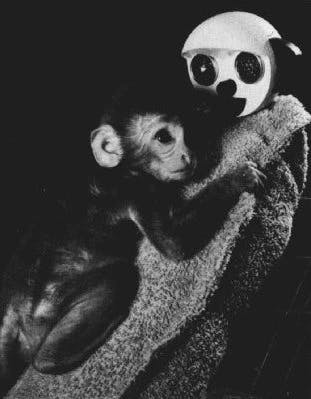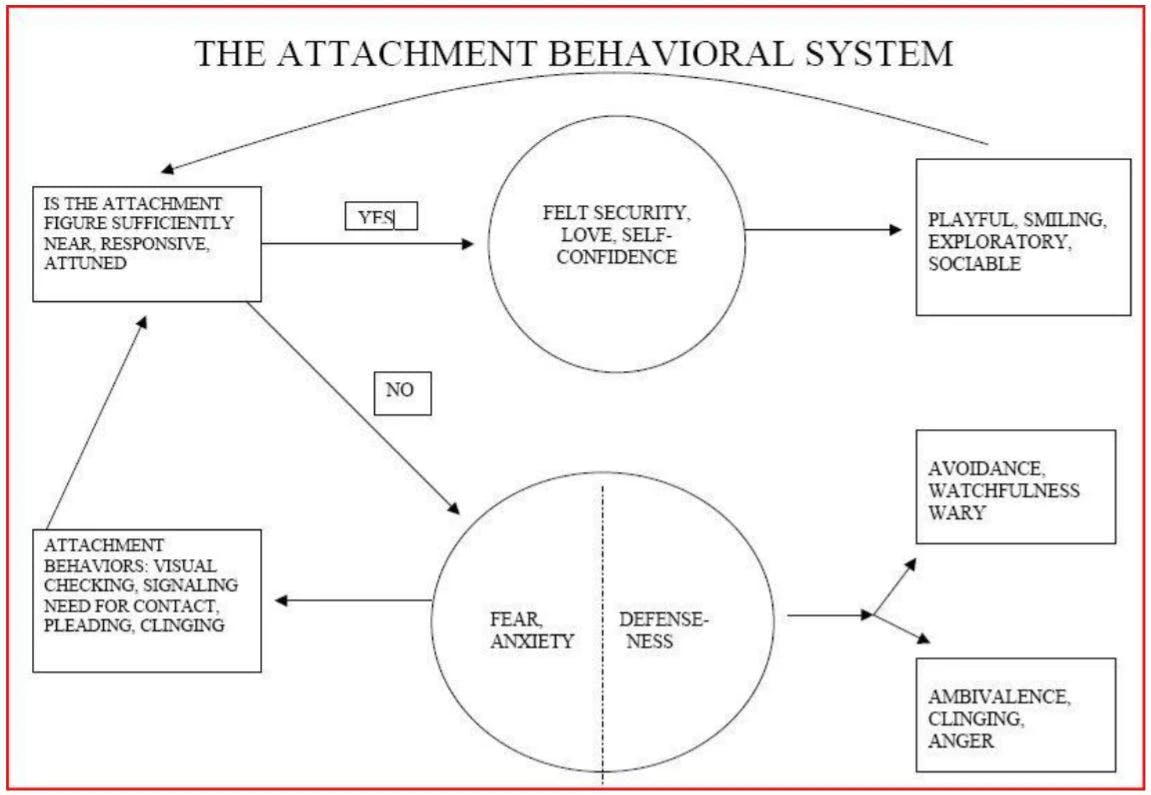Attachment Theory Can Explain Why You're Self-Sabotaging In Your Relationship
I’m washing the dinner dishes, mentally running through the list of everything else I need to do that evening, and it’s stressing me out. I look over at my husband at the table — not doing any of the things on my list.

I feel a sudden surge of resentment, immediately followed by the thought, “I should just ask him to help me.” This seemingly harmless thought results in several moments of anxious, inner turmoil where I struggle to overcome resistance and fear to open my mouth and ask for help.
Why is it so darn hard for me to ask for help? It wasn’t until I studied attachment theory that I got an answer.
A Brief History of Attachment Theory
Attachment theory is relatively new to the psychological development world. In the 1930s and ‘40s, researchers and psychologists started documenting their observations of “emotional starvation” and “failure to thrive.” But it wasn’t until the 1950s, when two very different experiments pointed to the same answers, that the established world of psychology was ready to listen and learn.
In the 1950s, researcher Harry Harlow demonstrated the importance of “contact comfort” in his now-famous baby monkey and surrogate mother experiments. In these experiments, baby monkeys were observed to see which they prioritized: a wire dummy “mother” with food or a soft, foam dummy “mother” without food. Overall, the monkeys significantly prioritized the soft “mother” without food. They would even cling to the soft dummy when scared. Harlow’s work showed that an emotional connection of comfort and felt safety was more important to the baby monkey than even food.

Image in the public domain.
John Bowlby and Mary Ainsworth Prove Attachment Theory
Harlow’s monkey experiments confirmed the findings of John Bowlby — the founder of attachment theory — and his assistant Mary Ainsworth. For decades, Bowlby had been insisting — against the contemporary, dominant Freudian trend — that people’s mental and emotional problems were caused by external relationships with real people (not subconscious fantasies). Bowlby argued that the “quality of the connection to loved ones and early emotional deprivation was key to the development of personality and to an individual’s habitual way of connecting with others.” But his papers (and even a documentary he made) were scoffed at by his fellow psychologists.
It wasn’t until Bowlby’s assistant Mary Ainsworth developed the “Strange Situation” experiment that they were finally able to prove Attachment Theory to a degree that defied denial.
What Was the “Strange Situation” Experiment?
A mother and young child were brought into a lab room (the strange environment) where a researcher (a stranger) was sitting. A few minutes later, the mother exited the room, and the child was left alone to play on the floor, while the researcher watched. Three minutes later, the mother returned and reengaged with her child. The researcher observed how the child acted when their mother left, how they reacted when their mother returned, and how the mother treated her child.
This experiment showed a correlation between specific ways mothers treated their children and specific ways the children acted. Children who had warm, responsive mothers could easily self-soothe and reconnect with their mother when she reentered the room. Children with cold, dismissive mothers were likewise distant and emotionally detached — they didn’t seem to care that their mother had come back. And mothers who acted unpredictably had children who were anxious, aggressive, clingy, and angry. These three behavioral correlations form three different styles of attachment.
What Is Attachment?
The “Strange Situation” demonstrated three distinct kinds of attachment bonds that can be formed between parent and child, depending on how the parent addresses the child’s needs and distress. (The fourth kind was added after studying the attachment bonds of children in abusive families.)
Distinct kinds of attachment form between parent and child, depending on how the parent addresses the child’s needs.
These attachment bonds form our view of ourselves and others; they tell us if we’re worthwhile and have agency, and if other people are trustworthy and accessible. Attachment bonds tell us how to get our needs met and if other people can help us to do that.
There are five behaviors at the heart of attachment:
We monitor and maintain emotional and physical closeness with our beloved.
We reach out for this person when we’re unsure, upset, or feeling down.
We miss this person when we’re apart.
We count on this person to be there for us when we go out into the world and explore.
We feel fear, anxiety, grief, and sorrow when faced with the threat of or the actual loss of the beloved.
These behaviors are present in infancy and childhood (our dependency on our parents) and in romantic relationships (how we rely on and interact with our partner). Let’s take a look at the four different kinds of attachment bonds.

The Secure Attachment Style
The secure attachment is the healthiest bond, and it’s formed by the parents’ quick and loving response to their child’s expression of need or distress, whether that’s feeding them, comforting them, changing a diaper, etc. This attentive behavior tells the child that they’re seen and capable of getting their needs met. The parent’s quick response also helps to calm the child’s adrenaline response, returning the child’s body to a state of calm, which does two things: 1) it teaches the child a healthy way to be comforted/soothed, and 2) it allows the brain to develop properly and to function at its best.
The secure child views himself as worthy of protection and love and others as trustworthy and reliable.
This pattern of parental response to a child’s needs builds the child’s sense of self. The child views himself as worthy of comfort, protection and love, and as able to get his needs met (he has agency in the world). His sense of other is also formed. The child views the parent as available and willing to comfort and care. The child trusts that the parent is reliable and dependable in times of need.
In romantic relationships as adults, secure individuals still function along the same lines, basically believing that they have agency and that their partner will be there for them and comfort them. People who are securely attached have more confidence in their relationship and the other person, so they’re less shaken by fights and can reconcile more easily.
Common characteristics of the securely attached individual:
They’re confident in who they are. They don’t feel pressured to perform or to please in order to “earn” love or self-worth.
They’re able to express their ideas or assert themselves without being terrified at the risk of rejection.
They’re able to take criticism more easily, without feeling personally attacked or rejected.
They’re able to regulate their emotions, self-soothe, and reflect on personal experiences and learn from them.
They’re able to respect other people’s feelings.
They can negotiate and communicate honestly without manipulation or coercion.
They’re not conflict avoidant.
They’re able to trust others and be vulnerable and intimate.
Insecure Style #1: Avoidant Attachment
In the “Strange Situation” experiment, the avoidant style babies showed very little, if any, distress when their mother left the room. Outwardly, they looked calm, but in follow-up studies, these children proved to be experiencing the same level of physiological distress as the secure and ambivalent children. They just suppressed their feelings (which can lead to toxic stress and impede brain development). When their mother reentered the room, these babies ignored her.
The avoidant attachment style forms when the parent refuses to meet the child’s bid for attention, love, or help. Their cries of distress go unanswered for too long because the parent is emotionally cold or distant. Alternatively, the parent might address their child’s needs, but do so without a loving, nurturing manner (like propping their baby up with pillows to bottle feed them instead of holding them). Sometimes the avoidant attachment is formed when the parent isn’t present enough to respond to the child during their formative years because of an extended illness, depression, alcoholism, etc.
The avoidant individual suppresses their feelings, eschews vulnerability, and assumes an attitude of confidence.
They feel other people aren't trustworthy.
This lack of appropriate parental response forms both the child’s sense of other and their sense of self. To the avoidant individual, other people aren’t reliable or trustworthy when it comes to helping them meet their needs. The avoidant individual’s sense of self is that “I have to take care of myself. I must rely on myself to get my emotional and physical needs met.”
They suppress their feelings.
Consequently, the avoidant individual suppresses their feelings (because their parents/others won’t acknowledge or validate them anyways), eschews vulnerability (to protect themselves from getting hurt again), and assumes an attitude of self-confidence (to tell others they can take care of themselves; they don’t need other people to help them). Avoidant people worry that if they let someone in — even a good person — eventually (at any time!) that person will hurt them and disappoint them. So it’s safer to not take that risk.
Common characteristics of the avoidant individual:
They avoid being vulnerable and building intimate emotional connections because it feels dangerous, or it reminds them of times in the past when they were hurt by the people they were close to.
They may struggle with nonsexual physical touch.
They may struggle to have empathy and compassion for others.
They can appear tough on the outside and keep people and their feelings at a distance in order to keep their own feelings at a distance.
They often fill the emotional connection void with an alternate substance: work, sports, substance abuse addictions, porn, hobbies, etc.
They often take failure and criticism personally — it means they’ve failed themselves, the “only person” they could rely on.
Can also manifest as narcissism, excessive self-sufficiency, or perfectionism.
Insecure Style #2: Ambivalent Attachment
The ambivalent attachment bond is formed when a parent is unpredictable — they swing from being attentive, loving, and caring to threatening to leave or being critical or cold. This causes the child to constantly question if their parent loves them or not.
It’s common for ambivalent individuals to have struggled with the question “Will my parent leave me?” or to have experienced parent loss. This fear of abandonment and the uncertainty of their parent's love are at the core of this attachment style. Consequently, the child becomes a people-pleaser and tries to fulfill their parents’ expectations, thinking this will keep their parents happy and close by. This way of living focuses on what others think, feel, say, and do, which creates a dependency — a feeling that you’re of little or no value without someone else giving you their approval.
It’s common for ambivalent individuals to have lived with the question “Will my parent leave me?”.
They feel undeserving of love.
The instability in the parent-child relationship creates the ambivalent individual’s view of self: “I’m not good at getting the love or the help I need. I’m incompetent.” This feeling of incompetency is complicated by their view of others: “I have to be perfect and make other people happy for them to view me as worthwhile and worth loving.” They feel a pressure to perform and to please (which often goes to the extreme of being a doormat), but they also feel like they don’t have what it takes. The ambivalent individual often lives according to the philosophy of “Don’t upset anyone, don’t assert yourself, just keep people happy, and they’ll have no reason to abandon you.”
Common characteristics of the ambivalent individual:
A parent-child role reversal (i.e. where a parent confides in a child, or gets their need for comfort met by the child) is common in the formative years in ambivalent style people.
They tend to be clingy and dependent on others.
They often struggle with overcoming obstacles because they’re burdened with self-doubt and very low self-confidence.
They’re often afraid to make big decisions on their own.
They frequently ask for advice.
They often work below their potential level.
They will do unpleasant tasks to please others.
Can also manifest in an anxious desire to always feel safe, in habitual melodrama, and in repressed anger.
Insecure Style #3: Disorganized Attachment
The disorganized attachment style is the result of abuse or trauma, especially recurring abuse or trauma. For disorganized individuals, their abusive family members were both the “source of and the solution to their fear.” Therefore, it’s not surprising that disorganized individuals have a negative sense of both themselves and others. They often feel stuck in a chaotic world with confusing relationships, impulsive behavior, and fluctuating emotions.
The disorganized child can’t understand or bear the way their parent mistreats them, so they reframe the situation by blaming themselves, which becomes their core sense of self: “The reason my mom hits me is because I’m a bad person and I can’t do anything right.” As an adult, this belief manifests as either being a doormat or in the need to overcontrol — sometimes both. Understandably, the disorganized individual sees others as not trustworthy or reliable to help them get their needs met. They might even think that other people hurt them because they deserve it.
Disorganized individuals commonly disassociate to cope with their experiences of abuse.
They often disassociate to deal with trauma.
One common coping mechanism that disorganized individuals use is disassociation. Disassociation is the psychological ability to cut off your thoughts, feelings, and experiences from your personal self and shift them to another space in your consciousness, so that it feels like “it’s not happening to me.” Young children often use disassociation as a coping method, especially for traumatic experiences that they can’t understand.
They ignore painful and traumatic memories.
Another form of dissociation is mentally burying memories and anything associated with the trauma. Ignore the problem, and it’s like it was never there, right? People who disassociate do so so they can function in daily life, and it’s often successful. But the damage done resurfaces in situations relating to intimacy, aggression, fear, and abandonment.
Common characteristics of the disorganized individual:
Children who disassociate as a coping mechanism can’t develop the ability to reflect on their interior life. This inhibits their sense of identity and their ability to learn and grow.
They usually have identity problems, meaning they don’t have a sense of “this is who I am no matter what’s going on around me.” A lack of identity contributes to a lack of stable follow-through in relationships, commitments, and goals. It also inhibits learning from past experiences and considering future consequences.
They struggle with self-soothing and emotional regulation.
They commonly suffer from panic attacks, high anxiety, deep depression, and a feeling of helplessness or inefficacy.
They fluctuate between all the attachment styles in their interactions.
Closing Thoughts
Learning about attachment theory was a big lightbulb moment for me. It explained why I act the way I do. And having that explanation helped me see where and why I needed to grow. So don’t get discouraged if you realize you have an insecure attachment style because healing is possible!
For more information about attachment theory and how to heal, read Attachments: Why You Love, Feel, and Act the Way You Do. For tips on how to strengthen your emotional attachment to your romantic partner, read Hold Me Tight. If you’re unsure what your attachment style is, take this handy quiz.